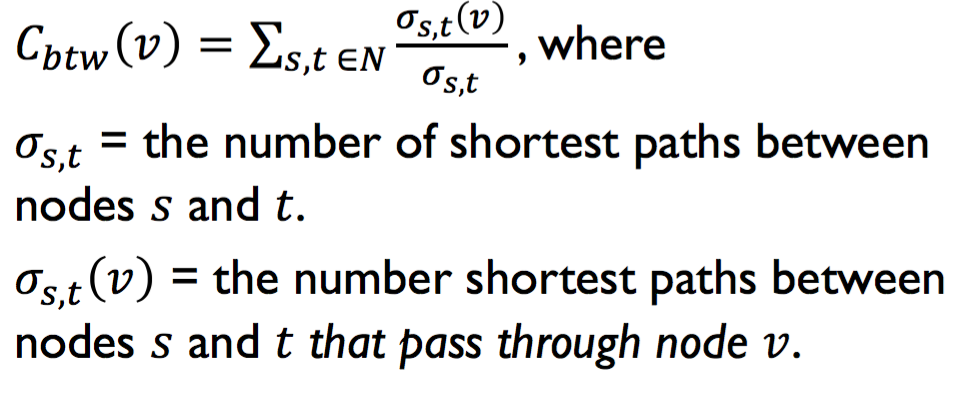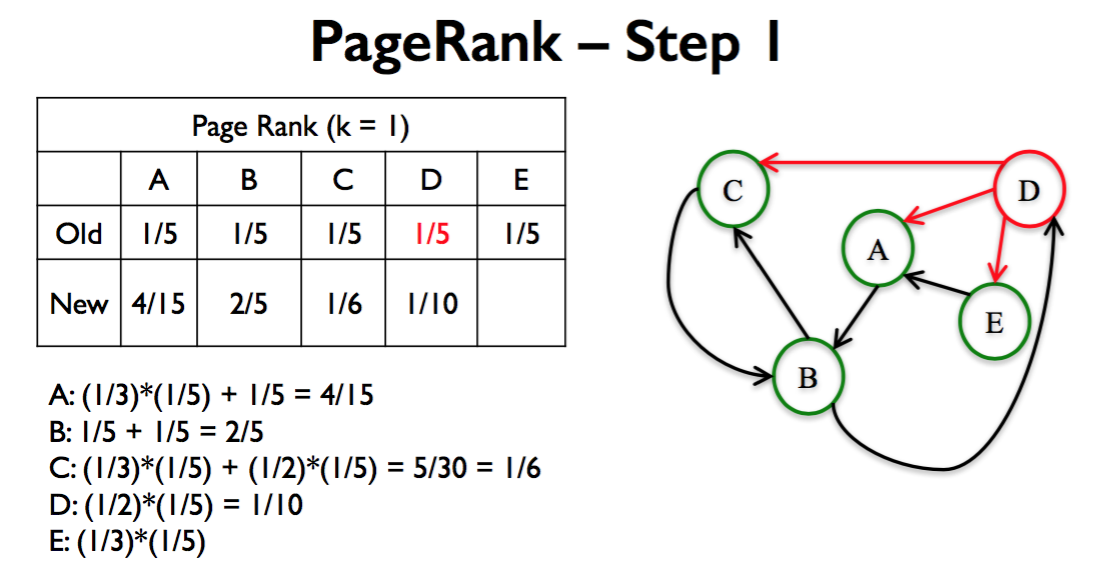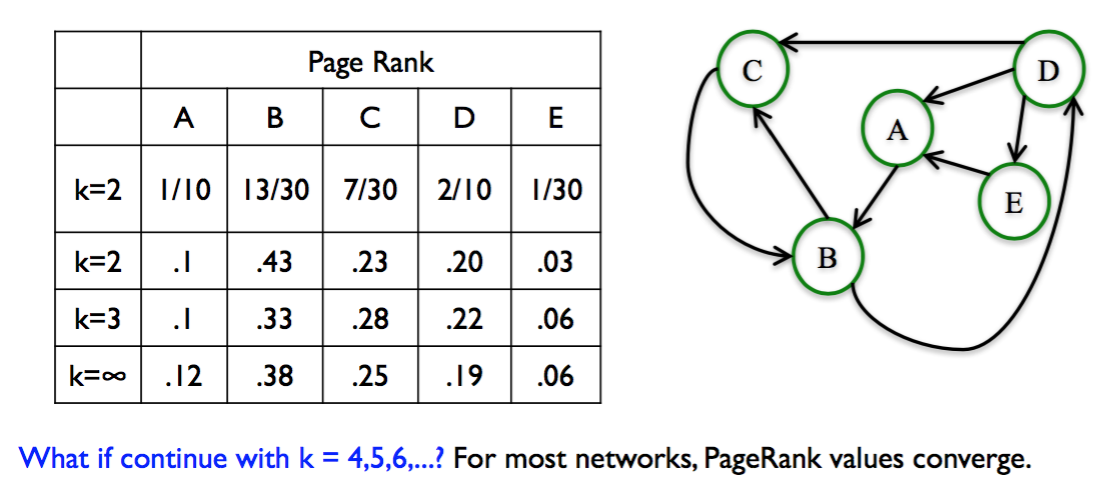5. Centrality¶
Centrality and other measures identify the most important nodes in a network.
5.1. Degree Centrality¶
Assumption: Important nodes have many connections.
Undirected networks: Use degree.
𝐶𝑣 = d𝑣/(𝑁 - 1) where 𝑁 is total number of nodes. Minus 1 to remove node in question 𝑑 is the degree of node 𝑣.
degCent = nx.degree_centrality(G)
# gives a dictionary. key = node, value = centrality ratio
degCent[34]
.. 0.515 # 17/33
Directed networks: use in-degree or out-degree
# in-degree centrality
indegCent = nx.in_degree_centrality(G)
indegCent[‘A’]
# out-degree centrality
indegCent = nx.out_degree_centrality(G)
indegCent[‘A’]
5.2. Closeness Centrality¶
Assumption: important nodes are close to other nodes. It is calculated by (total number of nodes that node N can reach) / sum(shortest path of node N).
closeCent =nx.closeness_centrality(G)
closeCent[32]
.. 0.541
# Manual calculation
sum(nx.shortest_path_length(G,32).values())
.. 61
(len(G.nodes())-1)/61.
.. 0.541
Normalisation (multiply a constant i.e., total # nodes in graph) is required for directed graphs, as node in question may only reach a few nodes in the entire graph.
nx.closeness_centrality(G, normalized= True)
closeCent[‘L’]
.. 0.071
5.3. Betweenness Centrality¶
Assumption: important nodes are those that connect other nodes.
What is the Betweenness Centrality of node v? This is between all possible paths between all sources & targets, taking into account the # shortest paths passing through that node v, over the total # shortest paths from the sources to targets.
End Points. Whether to include or exclude node v from as a source/target
Normalization. Divide by number of pairs of nodes.
Approximation. Computing betweenness centrality can be computationally expensive. We can approximate computation by taking a subset of nodes.
btwnCent = nx.betweenness_centrality(G, endpoints = False, #include/exclude node v in source/target
normalized = True,
k = 10) #approximation
import operator
sorted(btwnCent.items(), key=operator.itemgetter(1), reverse = True)[0:5]
# [(1, 0.43763528138528146),
# (34, 0.30407497594997596),
# (33, 0.14524711399711399),
# (3, 0.14365680615680618),
# (32, 0.13827561327561325)]
Subsets. We can define subsets of source and target nodes to compute betweenness centrality.
nx.betweenness_centrality_subset(G, [34, 33, 21, 30, 16, 27, 15, 23, 10], #source nodes
[1, 4, 13, 11, 6, 12, 17, 7], #target nodes
normalized=True)
import operator
sorted(btwnCent_subset.items(),key=operator.item getter(1), reverse=True)[0:5]
# [(1, 0.04899515993265994), (34, 0.028807419432419434),
# (3, 0.018368205868205867),
# (33, 0.01664712602212602),
# (9, 0.014519450456950456)]
Edge betweenness centrality. We can apply the same framework to find important edges instead of nodes.
btwnCent_edge = nx.edge_betweenness_centrality(G, normalized=True)
import operator
sorted(btwnCent_edge.items(), key=operator.itemgetter(1), reverse = True)[0:5]
# [((1, 32), 0.12725999490705373),
# ((1, 7), 0.07813428401663694),
# ((1, 6), 0.07813428401663694),
# ((1, 3), 0.0777876807288572),
# ((1, 9), 0.07423959482783014)]
# similar function for subset
nx.edge_betweenness_centrality_subset()
5.4. Basic Page Rank¶
PageRank assigns a score of importance to each node. Important nodes are those with many in-links from important pages.
Steps of Basic PageRank
- All nodes start with PageRank of 1/𝑛
- Perform the Basic PageRank Update Rule k times:
- Summary
- Basic Page Rank Update Rule: Each node gives an equal share of its current PageRank to all the nodes it links to.
- The new Page Rank of each node is the sum of all the Page Rank it received from other nodes.
- For most networks, PageRank values converge as k gets larger (𝑘 → ∞)
5.5. Scaled Page Rank¶
- The Basic PageRank of a node can be interpreted as the probability that a random walk lands on the node after 𝑘 random steps.
- Basic PageRank has the problem that, in some networks, a few nodes can “suck up” all the PageRank from the network.
- To fix this problem, Scaled PageRank introduces a parameter 𝛼, such that the random walker chooses a random node to jump to with probability 1 − 𝛼.
- Typically we use 𝛼 between 0.8 and 0.9
- NetworkX function
nx.pagerank(G, alpha=0.8)computes Scaled PageRank of network G with damping parameter 𝛼=0.8.
5.6. HITS Algorithm¶
Hyperlink-Induced Topic Search (HITS; also known as hubs and authorities) is a link analysis algorithm that rates Web pages.
- The HITS algorithm starts by constructing a root set of relevant web pages and expanding it to a base set.
- HITS then assigns an authority and hub score to each node in the network.
- Nodes that have incoming edges from good hubs are good authorities, and nodes that have outgoing edges to good authorities are good hubs.
- Authority and hub scores converge for most networks.
- You can use NetworkX function
nx.hits(G)to compute the hub and authority
scores of network G
5.7. Comparison¶
The best centrality measure depends on the context of the network one is analysing.
When identifying different nodes, best to use multiple centrality measures instead of a single one.




